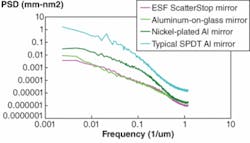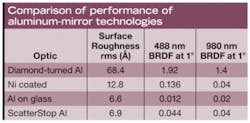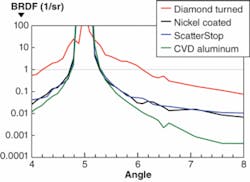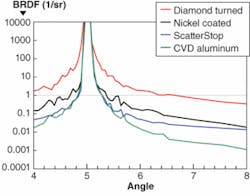KEVIN MOEGGENBORG, FRANCOIS BATLLO, DANIEL McMULLEN, AND STAN REGGIE
A combination of physical properties makes aluminum very attractive as an optical material. It has excellent reflectivity over a spectral range that includes the entire visible spectrum and extends into the ultraviolet (UV) and infrared (IR) regions. Aluminum is also lightweight, can be readily machined with standard tools, has high thermal conductivity, and can be alloyed with other metals to attain a high stiffness. Finally, aluminum is inexpensive and without the health concerns of beryllium, which is one alternative material for many mirror applications.
Polishing aluminum optics
Despite its unique properties, aluminum is a challenging material on which to achieve an optical finish. Most commonly, single-point diamond turning (SPDT) is used to produce aluminum mirrors, resulting in a diamond-turned mirror surface that has a directional lay pattern from the metal cutting action of the diamond-tool tip across the work piece. These diamond-turning marks can act as a grating and increase diffraction and scatter of the reflected beam. Attempts to post-polish SPDT mirrors typically produce inferior optical surfaces because of the tendency of aluminum to scratch and smear. These characteristics have limited the use of SPDT aluminum mirrors primarily to IR applications that are less sensitive to scatter.
For more scatter-sensitive applications, a common alternative is to plate SPDT aluminum mirrors with nickel, which can then be polished to an optical finish. While this process effectively reduces scatter, the coefficient of thermal-expansion difference for nickel versus aluminum causes the nickel-plated mirrors to suffer from bimetallic effects that can lead to degradation of form accuracy or delamination failures in applications in which temperatures vary. In addition, the nickel plating and finishing processes can add significant cost and lead time to the production of mirror components anddue to the lower inherent reflectivity of nickel versus aluminumrequires additional enhancement coatings to meet many system specifications for reflectance.
Another common alternative for more-scatter-sensitive applications is to use metalized glass mirrors. Primarily used for plano mirrors, these can be cost-effective, high-quality mirrors with very low scatter properties; however, system designers must accept the higher weight and more complicated mounting requirements compared to monolithic metal mirrors.
CMP technique
Many of the processing problems of aluminum originate in the inherent softness of the metal. Mechanical polishing techniques using hard abrasives tend to scratch, smear, or even embed abrasive particles in the material surface.1 In our proprietary ScatterStop process, we have adapted chemical-mechanical polishing (CMP) technology from the integrated-circuit industry to the polishing of optical components.
The principle of CMP is based on a balance between chemical reaction and mechanical abrasion of the material to be polished, to provide a finished surface with the required properties. The ScatterStop process utilizes an abrasive slurry containing one or more chemical additives that interact with the work piece. In the case of aluminum, the slurry chemistry enables the formation of an oxidized layer on the metal surface, while the abrasive component removes the soft oxide layer through the action of a polishing pad. This chemically enhanced process allows smaller abrasive particles and more gentle polishing conditions than a strictly mechanical polish. As a result, the process gives good material removal and can yield extremely high-quality scratch-free surfaces on a variety of aluminum materials such as 6000 series alloys, 7000 series alloys, and pure aluminum (see Fig. 1).
Performance metrics for optics polishing are different from those required for the IC industry. While defectivity is a key metric (in terms of scratches and embedded particles) in the IC industry, low roughness is not as crucial and is often not characterized. In addition, IC slurries are designed to have specified polishing rates on a variety of materials present in the IC. For our optics application, we are concerned only about aluminum polishing, but we have the added requirements of surface finish and figure control.
For aluminum optics we were able to reduce an IC slurry to only its components affecting aluminum removal and finish. Abrasive particle size and concentration are crucial parameters to control removal rate, surface finish, and even figure control. For optics, the combination of abrasive and chemistry must be strong enough to work through the damage layer of the prepolished part (typically, diamond-turned or mechanically lapped) without degrading the figure of the part.
ScatterStop performance
One method for characterizing the scatter performance of mirror surfaces is to measure the power spectral density (PSD), defined as the Fourier transform of the roughness data into the frequency domain.2 The PSD measurement shows that the ScatterStop mirror is significantly better than the SPDT mirror, supporting the claim that ScatterStop technology can produce high-quality, low-scatter mirror surfaces when compared with common alternatives (see Fig. 2).
While measured roughness is an indicator of potential benefits of the CMP technique, it is not a direct measurement of performance in an actual application. A better indicator of actual performance is the bidirectional reflectance distribution function (BRDF).2 The BRDF is basically a measurement of the scattered light intensity as a function of angle and incident light intensity and is defined as:
Where Pi and Ps are the incident and scattered power, respectively, Ωs is the solid angle of the scattered light, and θs is the scattered angle measured from normal. The BRDF parameter can be defined for different incident angles, wavelengths, and polarizations of light. Per the equation, a high BRDF value would indicate more light scattering from the mirror.
In practice, the BRDF measurement involves shining a laser light source of a given wavelength onto the sample at some angle from normal. The level of scattered light is measured by a detector as a function of angle from 90° to 0°. For imaging applications in which image clarity and contrast are most important, optical systems usually involve incident and reflected beams at angles near the specular reflection. For this reason, the discussion of BRDF data focuses on light scattered within a few degrees of specular.
To evaluate the comparative performance of aluminum mirror technologies, we characterized the BRDF of several mirror types including an SPDT bare aluminum mirror, a nickel-coated and polished mirror, an enhanced aluminum-on-glass mirror, and a ScatterStop-polished bare aluminum mirror. Surface roughness for each mirror was measured using a Zygo (Middlefield, CT) white-light interferometer with a scan size of 260 × 350 µm. Although the diamond-turned mirror (SPDT) had an average roughness of 68 Å root-mean-squared (rms), fairly typical for a diamond-turned part, the other three mirrors all had surfaces with roughness under 15 Å rms (see table, p. 91). The BDRF measurements were performed with an incident beam reflected at 5° from normal at the surface of each mirror at 488 nm (visible) and 980 nm (near-IR) wavelengths and were measured 1° from the specular reflectance.
Analysis of a plot of the near-angle BRDF data collected at 980 nm shows nearly identical performance over this range for nickel-plated and ScatterStop mirrors (see Fig. 3). The aluminum-on-glass mirror produced less scattered light (lower BRDF reading) over most of the range, while the diamond-turned mirror showed levels of scattered light approximately one order of magnitude higher than the ScatterStop and nickel-coated mirrors.
The BRDF results collected at 488 nm showed a wider range of performance. The diamond-turned mirror remains approximately an order of magnitude worse than the nickel-coated mirror over most of the range (see Fig. 4). At this shorter wavelength, however, the ScatterStop mirror produces less scatter than the nickel-coated mirror and performs more like the aluminum-on-glass mirror. Measuring the BRDF 1° off from specular, the scatter from the ScatterStop mirror is a factor-of-three lower than the nickel-plated mirror and nearly two orders of magnitude lower than the diamond-turned mirror (see table).
The low surface roughness and isotropic surface obtained for ScatterStop mirrors results in lower light scattering and extends the usefulness of bare aluminum optics beyond IR into visible and UV applications. Fixturing, machining, and mounting options for monolithic, all-metal mirrors are far more flexible compared to coated glass mirrors. In addition, because many optical systems are constructed of aluminum materials, bare aluminum mirrors allow for the construction of athermal systems.
ACKNOWLEDGMENT
The authors would like to acknowledge the contributions of John Stover from The Scatter Works (Tucson, AZ) for the BRDF measurements and analysis.
REFERENCES
1. M.F. Da Silva et al., Corrosion Science 37(9) 1511 (1995).
2. J.C. Stover, Optical Scattering: Measurement and Analysis, SPIE Optical Engineering Press (1995).
KEVIN MOEGGENBORG is senior scientist, FRANCOIS BATLLO is R&D director, and DANIEL McMULLEN and STAN REGGIE are directors of business development for Cabot Microelectronics, 870 North Commons Drive, Aurora, IL 60504; e-mail: [email protected]; www.cabotcmp.com.





